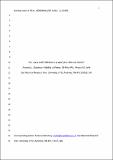Files in this item
Can a gray seal (Halichoerus grypus) generalize call classes?
Item metadata
| dc.contributor.author | Stansbury, Amanda | |
| dc.contributor.author | de Freitas, Mafalda | |
| dc.contributor.author | Wu, Gi-Mick | |
| dc.contributor.author | Janik, Vincent M. | |
| dc.date.accessioned | 2015-10-19T15:40:00Z | |
| dc.date.available | 2015-10-19T15:40:00Z | |
| dc.date.issued | 2015-11 | |
| dc.identifier | 205837008 | |
| dc.identifier | 5462cded-08f8-4d0e-bd5b-2c7076b858c0 | |
| dc.identifier | 84947489450 | |
| dc.identifier | 000365080000012 | |
| dc.identifier.citation | Stansbury , A , de Freitas , M , Wu , G-M & Janik , V M 2015 , ' Can a gray seal ( Halichoerus grypus ) generalize call classes? ' , Journal of Comparative Psychology , vol. 129 , no. 4 , pp. 412-420 . https://doi.org/10.1037/a0039756 | en |
| dc.identifier.issn | 0735-7036 | |
| dc.identifier.other | ORCID: /0000-0001-7894-0121/work/60427871 | |
| dc.identifier.uri | https://hdl.handle.net/10023/7670 | |
| dc.description.abstract | Past researchers have found that gray seals (Halichoerus grypus) are capable of classifying vocal signals by call type using a trained set, but were unable to generalize to novel exemplars (Shapiro, Slater, & Janik, 2004). Given the importance of auditory categorization in communication, it would be surprising if the animals were unable to generalize acoustically similar calls into classes. Here, we trained a juvenile gray seal to discriminate novel calls into 2 classes, “growls” and “moans,” by vocally matching call types (i.e., the seal moaned when played a moan and growled when played a growl). Our method differed from the previous study as we trained the animal using a comparatively large set of exemplars with standardized durations, consisting of both the seal’s own calls and those of 2 other seals. The seal successfully discriminated growls and moans for both her own (94% correct choices) and the other seals’ (87% correct choices) calls. We used a generalized linear model (GLM) and found that the seal’s performance significantly improved across test sessions, and that accuracy was higher during the first presentation of a sound from her own repertoire but decreased after multiple exposures. This pattern was not found for calls from unknown seals. Factor analysis for mixed data (FAMD) identified acoustic parameters that could be used to discriminate between call types and individuals. Growls and moans differed in noise, duration and frequency parameters, whereas individuals differed only in frequency. These data suggest that the seal could have gained information about both call type and caller identity using frequency cues. | |
| dc.format.extent | 681626 | |
| dc.language.iso | eng | |
| dc.relation.ispartof | Journal of Comparative Psychology | en |
| dc.subject | Classification | en |
| dc.subject | Generalization | en |
| dc.subject | Discrimination | en |
| dc.subject | Gray seal | en |
| dc.subject | Call types | en |
| dc.subject | QH301 Biology | en |
| dc.subject | GC Oceanography | en |
| dc.subject.lcc | QH301 | en |
| dc.subject.lcc | GC | en |
| dc.title | Can a gray seal (Halichoerus grypus) generalize call classes? | en |
| dc.type | Journal article | en |
| dc.contributor.sponsor | NERC | en |
| dc.contributor.institution | University of St Andrews. School of Biology | en |
| dc.contributor.institution | University of St Andrews. Scottish Oceans Institute | en |
| dc.contributor.institution | University of St Andrews. Sea Mammal Research Unit | en |
| dc.contributor.institution | University of St Andrews. Marine Alliance for Science & Technology Scotland | en |
| dc.contributor.institution | University of St Andrews. Institute of Behavioural and Neural Sciences | en |
| dc.contributor.institution | University of St Andrews. Centre for Social Learning & Cognitive Evolution | en |
| dc.contributor.institution | University of St Andrews. Bioacoustics group | en |
| dc.identifier.doi | 10.1037/a0039756 | |
| dc.description.status | Peer reviewed | en |
| dc.identifier.grantnumber | NE/I024682/1 | en |
This item appears in the following Collection(s)
Items in the St Andrews Research Repository are protected by copyright, with all rights reserved, unless otherwise indicated.

